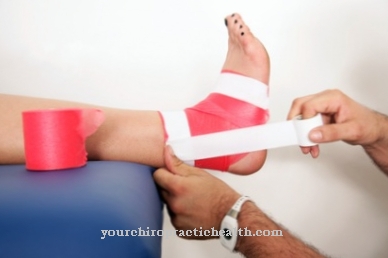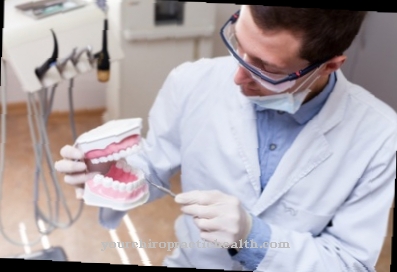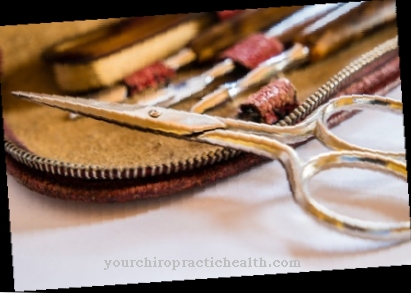At a Prosthetic eye it is an artificial eye. It serves as a cosmetic replacement for a lost eye.
What is an eye prosthesis?

An eye prosthesis is understood to mean an artificial eye. It is also common as Glass eye known. It is used as an aid to improve the patient's facial aesthetics. She is unable to restore eyesight.
An eye prosthesis is used after surgical removal or the loss of an eye due to an accident. An eye prosthesis is made by specially trained ocularists. These complete an apprenticeship period of 6 to 7 years and must have special manual skills and artistic talent. They are also known as ophthalmic prosthetists, artificial eye manufacturers, or eye artists.
In Germany there have been eye prostheses since the 19th century, which are manufactured entirely by hand. The production of the first artificial eye in Germany took place in Lauscha in 1835.
Shapes, types & types
Eye prostheses can be divided into several forms. Hole prostheses are initially used as part of initial medical care. These are collection eyes that have a hole. In this way the supply of medicines is facilitated. The so-called conformers represent another variant. These are individually manufactured prostheses without an iris drawing. They are used to reconstruct the adnexa or orbit (eye socket).
Once the wound healing process in the eye socket is complete, another prosthesis is usually provided. This is necessary to ensure that the prosthetic eye is correctly positioned. A distinction is made between single-walled shell prostheses, single-walled special prostheses and double-walled reform prostheses.
A single-walled shell prosthesis is used to cover eye stumps or seals when the eyeball has shrunk, the implant is extremely large, or the eye sockets offer little space and support. This can be the case, for example, with malocclusion of the eyelid. A single-walled special prosthesis is used when the eye is still present but has shrunk or blinded and there is a malalignment. Double-walled reform prostheses are used to supply deep-seated seals or eye stumps.
Structure & functionality
Eye prostheses are always individual one-offs. They consist either of Kyrolith glass or plastic. The manufacture of the eye prosthesis is based on the detail and color of the second eye, which is still healthy. Tiny details such as the color of the eye body, the iris and the red conjunctival veins, which are different for each person, are taken into account. With the help of heated glass filament sticks, the ocularist simulates them within the artificial eye.
Kyrolith glass is a special type of glass that has been used in Germany since around 1850. The material of this glass eye is subjected to a fire polishing and has a very smooth and dense surface. Eye prostheses made of Kyrolith glass have the property of being well tolerated and easy to care for. Furthermore, they offer a pleasant wearing comfort. The glass eyes do not contain harmful substances. With their tissue neutrality, they ensure good hygiene.
A glass prosthesis, like the healthy eye, is supplied with tear fluid, which prevents it from drying out and gives it a natural shine. There were also no impairments when blinking.
The production of a glass prosthesis can be accomplished in a single session. However, since a glass eye is relatively fragile, the user should always exercise caution when inserting and removing the eye prosthesis.
In addition to eye prostheses made of Kyrolith glass, plastic prostheses are also used. They are made from the medical plastic PMMA. Compared to the glass eye, they have the great advantage of being unbreakable. However, the plastic prostheses are more difficult to handle. In addition, there is a risk of inflammation of the eye socket due to improper manufacture. Making a plastic ocular prosthesis usually requires two visits to an ocularist. It is also recommended to have the prosthesis polished by a professional every six months. The plastic prosthesis must be replaced after about four years.
For use, the eye prosthesis is simply inserted into the eye socket and then removed again. It is advisable not to insert and remove over hard surfaces such as tiles or sinks.
You can find your medication here
➔ Medicines for painMedical & health benefits
The use of an eye prosthesis is used for cosmetic purposes and restores the harmony of the face. The eyesight, however, cannot be reproduced by the artificial eye. An eye prosthesis is usually used after the loss of an eye. This can occur due to an illness, an accident, or an operation such as enucleation, which is the surgical removal of the eye. The same applies to tumor operations, where a lot of tissue is lost.
If neighboring body structures are also affected, the eye prosthesis is occasionally combined with an epithesis. It may also be necessary to remove a blind eye, which is a constant source of pain for the patient. Replacing an eye with an eye prosthesis is also useful for cosmetic reasons, for example when the eye is shrinking.
Eye prostheses have the advantage that they often look very similar to a healthy eye. In some cases the prosthesis can even be moved a little, albeit with restrictions. An eye prosthesis is often barely recognizable for laypeople, which makes life easier for those who wear artificial eyes. In this way, those affected achieve a higher quality of life.
The use of an eye prosthesis is not always possible. A common contraindication is the presence of conjunctival problems.




.jpg)























